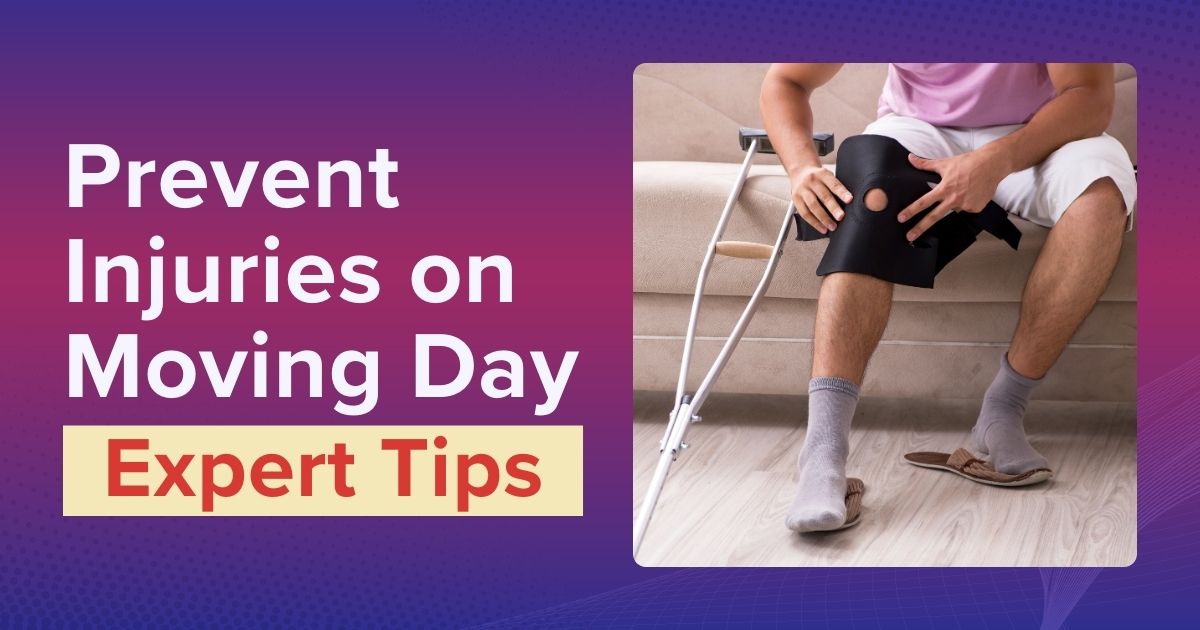Moving to a new home is always exciting, but that shouldn’t get in the way of avoiding injury on a moving day.
With insights from our residential moving experts and a few physiotherapists, our moving day guide should help you avoid injuries during the moving process. We thought about this issue from every angle, including the best clothes to wear when moving, proper lifting techniques, etc.
There are numerous reasons you may become injured in the moving process. To help lower the risk of injury, here are some tips and reminders that will help you with a smooth relocation.
11 Moving Day Safety Tips from Physiotherapists & Experienced Movers
To help you avoid injury while moving, we asked our moving experts and some physiotherapists for as much advice as possible. From stretching to lifting to hydration, they gave us the moving day play-by-play so you can stay safe.
1. Take care of your lower back
All the experts we consulted have encountered a variety of common injuries associated with moving days, including strains from bending and lifting heavy or awkward items.
“We see many clients during or after a house move,” says JR Justesen, PT, FCAMPT, CGIMS, who owns Parkway Physiotherapy & Performance Centre in Langford, BC.
Lower Back Pain is the Most Common
JR says the most common complaint during these periods of moving is low back strains.
Though most of us are aware of good lifting technique (using your legs and keeping the weight near your centre), we are most often injured at that moment when we’re not thinking about what we’re doing and when reaching to place a box or item into an awkward space.”
Not all injuries can be prevented, but the advice in this article can help.
That said, if an injury does occur, immediately stop the activity. Apply first aid if needed, and seek medical attention for serious injuries.
2. Do stretching before lifting
Jenny Fritts, a physiotherapist at Mercy Medical Center in Baltimore, Maryland, gave us some incredible injury prevention lifting tips during the move.
Not surprisingly, they start with some simple stretching, emphasizing the importance of warming up the muscles before engaging in any moving activity.
How to stretch before lifting to avoid injury?
According to Jenny, “Stretching helps the muscles warm up and prepare for positions required throughout moving day. Before moving day starts, and after it ends, it would be beneficial to make a hamstring stretch on both legs, a lunge or a hip flexor stretch on both legs, and a cross-body arm stretch on both arms.”
Jenny suggests holding each stretch for 20 seconds, three times on each side, and repeating throughout the day if you feel your body is getting tight or stiff.
3. Use Good lifting techniques
Lifting things efficiently means less effort for you, and it could save your back.
The basics of good lifting are to bend at the knees, not the waist, and use the strength of your legs to lift objects.
Here are Jenny Fritts’ specific instructions:
- Position yourself close to the item with feet shoulder-width apart, squat down using your legs, bend your knees, and keep your trunk upright while tightening your core.
- Ensure you have a firm grip on the item so you are not struggling with your grip while carrying it.
- Pick up the item and hold it close to your body at the belly button level.
- Avoid twisting while carrying something or while picking the item up off the floor.
- When setting an item down, go in reverse and squat down with your legs by bending your knees, and keep both core tight and trunk upright, then gently set the item down.
- Listen to your body. If you have a history of shoulder, back, or leg injury and do not feel comfortable or confident that you can lift something, trust your gut and have someone else do the heavy lifting.
When we ignore our gut feeling that something might be too heavy or awkward to carry alone, we are at the highest risk of injury.
Additionally, physiological conditions could impact the proper lifting technique recommended above. In that case, it is best to ask for help, or hiring professional movers is a safer option to prevent injury.
4. Using equipment to lift things safety
Invest in quality moving equipment such as dollies and straps. These tools make transporting heavy items much safer.
- Moving straps: essential for all moves.
- Dollies or hand trucks: for a safe move of your furniture.
- First-aid kits: for the health and safety of yourself and your movers.
- Work gloves: to protect yourself when moving heavy, sharp or slippery items.
Stock the first aid kit with bandages, antiseptic wipes, pain relievers, and necessary medications, and familiarize yourself with basic first aid procedures, such as treating minor cuts or strains.
5. Team communication
Having help while you move is a great way to prevent injury by distributing the weight of heavy items.
“Don’t be the hero,” says Chad Watters, owner of Lake Country Physiotherapy in Orillia, Ontario. “Accept help from others – most people truly want to help without strings attached!”
Chad tells us that lifting large items can lead to a breakdown in our mechanics. Special consideration needs to be given to these items, and they may need team lifts despite being lighter. He recommends lifting items as a team for anything heavier than 60 lbs/27 kg.
Remember to communicate to your team about potential hazards you’ve observed in the location you’re moving from and the one you’re moving into.
6. Rest and take breaks on a moving day
Schedule regular breaks to rest and recharge. Repetitive work leads to fatigue and a higher risk of using sloppy techniques, damaging furniture, or (worse) our bodies.
Are you feeling tired outside of the scheduled break time?
Don’t push through fatigue as it can increase the risk of injuries. Sit and rest, escape the hot or cold weather, and drink some water.
7. Stay hydrated on a moving day
The moving experts and physiotherapists we asked all agree hydration is critical.
Hydrating throughout the day is always important, especially when exerting physical effort and sweating. While not immediately fatal, moving-day dehydration can lead to:
- Fatigue
- Muscle cramps
- Dizziness
- Weakness
- Confusion
Drink plenty of water before, during and after moving day, and further avoid dehydration by limiting food and drinks known to cause dehydration.
8. Child and pet safety
Moving with kids and pets adds many more potential risks to the mix. For an injury-free move with dogs or little ones, it is advisable to have a trusted family member, friend, or caregiver look after them in a separate location.
If they must be on-site during the move, keep the kids secure in a separate room or the backyard with a trusted caregiver to keep them away from the action.
9. Packing and organizing for an injury-free moving day
How you pack for a move and label items can greatly affect how you and your movers avoid injury on a moving day.
Follow these suggestions –
- Pack in stages, never last minute, starting with the items you use the least and working your way towards the things you use daily, which you will pack at the end.
- Use sturdy boxes for heavier items and pack them strategically according to their density.
- Distribute weight evenly in the boxes you’re packing to prevent awkward and unbalanced lifting that puts strain on one side of your body.
- Don’t just label your fragile boxes; indicate if a box is extra heavy and requires multiple people to lift and carry it.
10. Choosing Safe and Comfortable Attire for Moving Day
Now the next question arises, what to wear to prevent injury during the move?
Well, our movers suggest that you should opt for comfortable, non-restrictive clothing and closed-toe shoes with good grip. You want to wear something light and stretchy to move your body without feeling restricted. Restrictive clothing may cause you to compromise your lifting and carrying technique unknowingly.
If you have additional safety clothing that makes sense, like steel-toe boots or a high-visibility vest, to wear while loading and unloading the truck, feel free to use it.
11. Clear the hallways, doorways, and stairs
Finally, use the time before move day to remove obstacles and create clear pathways for moving large furniture pieces. If you have access to the new space, inspect it for loose rugs, slippery surfaces, or low-hanging obstacles; at the very least, do this at the location you’re moving from.
Conclusion
Prioritizing safety on a moving day is key to a smooth transition to your new home. By following these expert tips and being mindful of your body’s signals, you can avoid common injuries and make the DIY moving process a positive experience.
If you want to avoid all potential injuries, you can choose the right moving company to pack, move, and unpack for you. This solution is ideal for older adults, people with chronic pain or recent injuries, parents with young kids, and anyone moving for the first time.


















